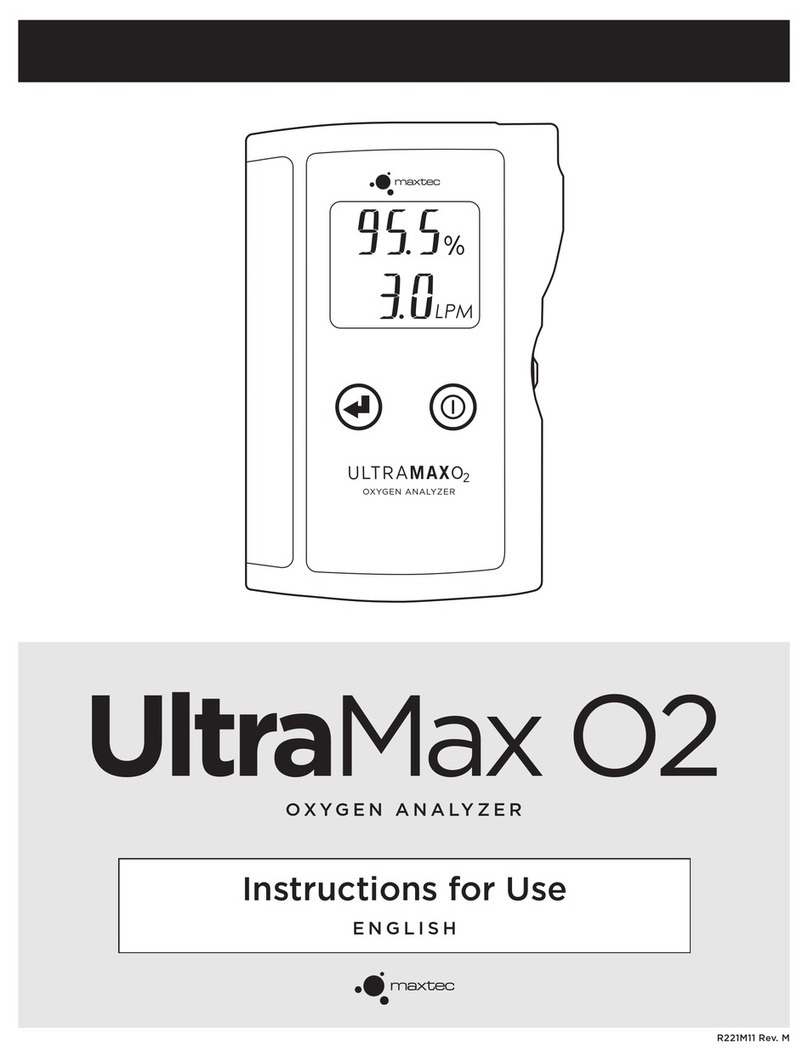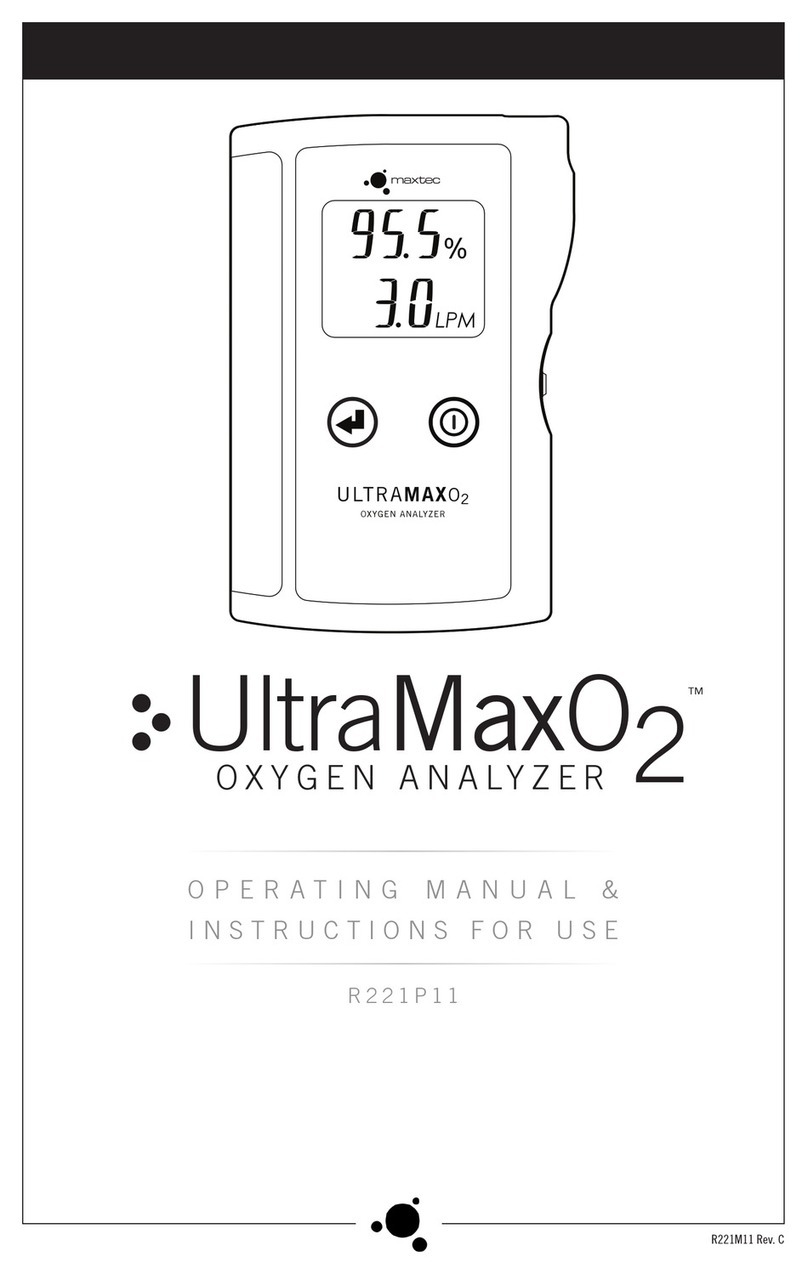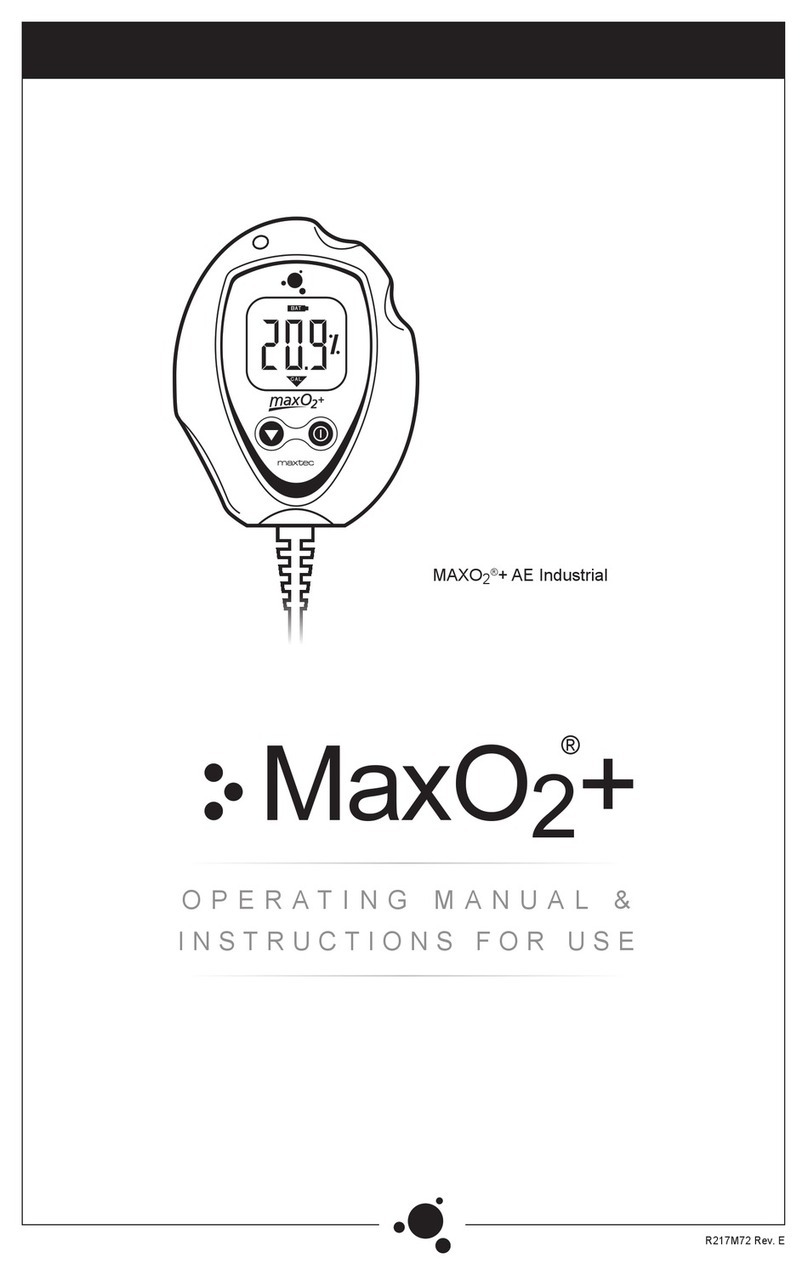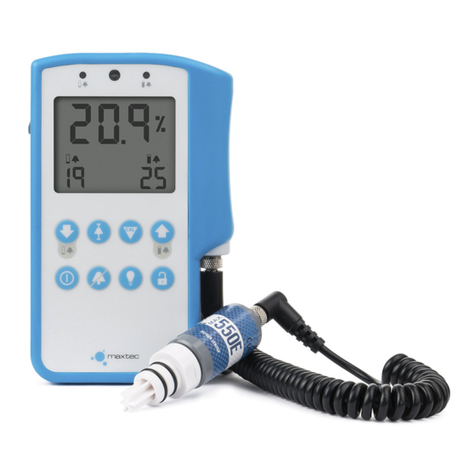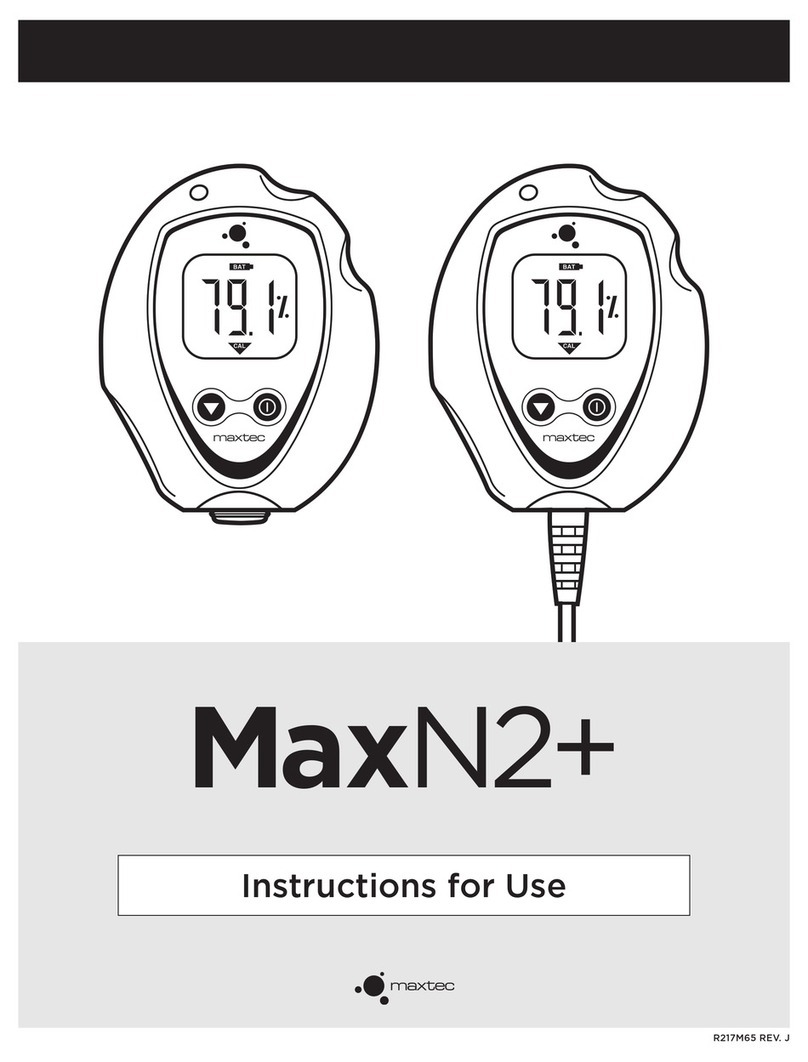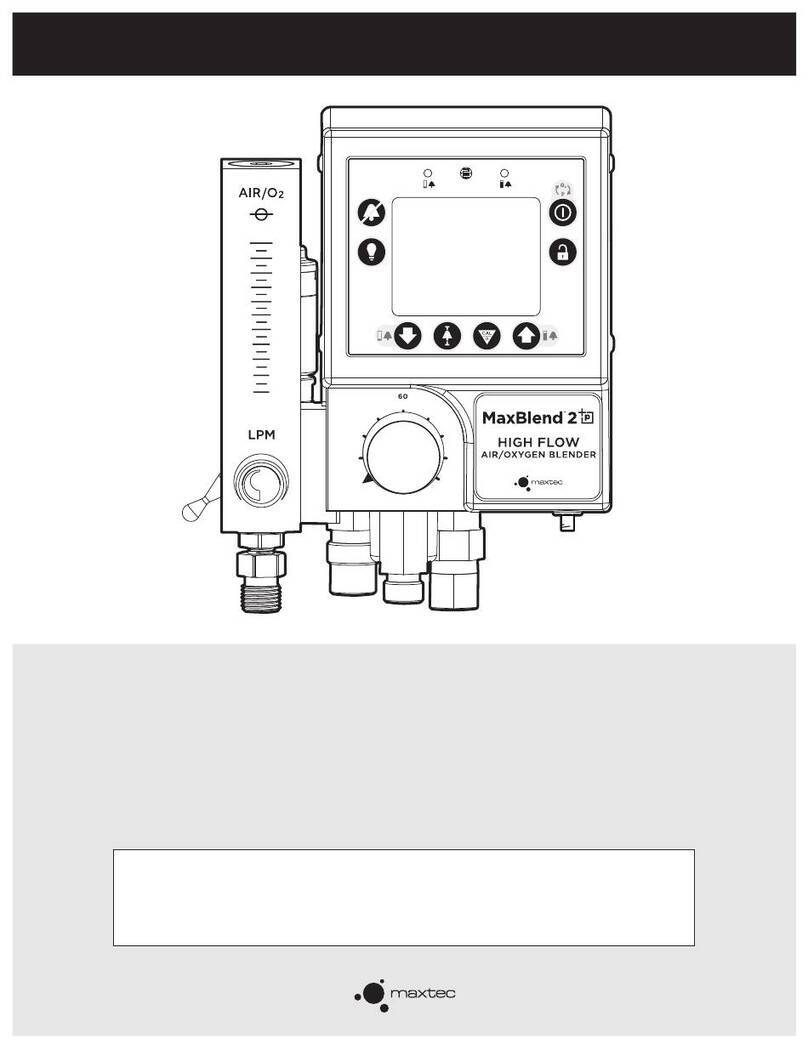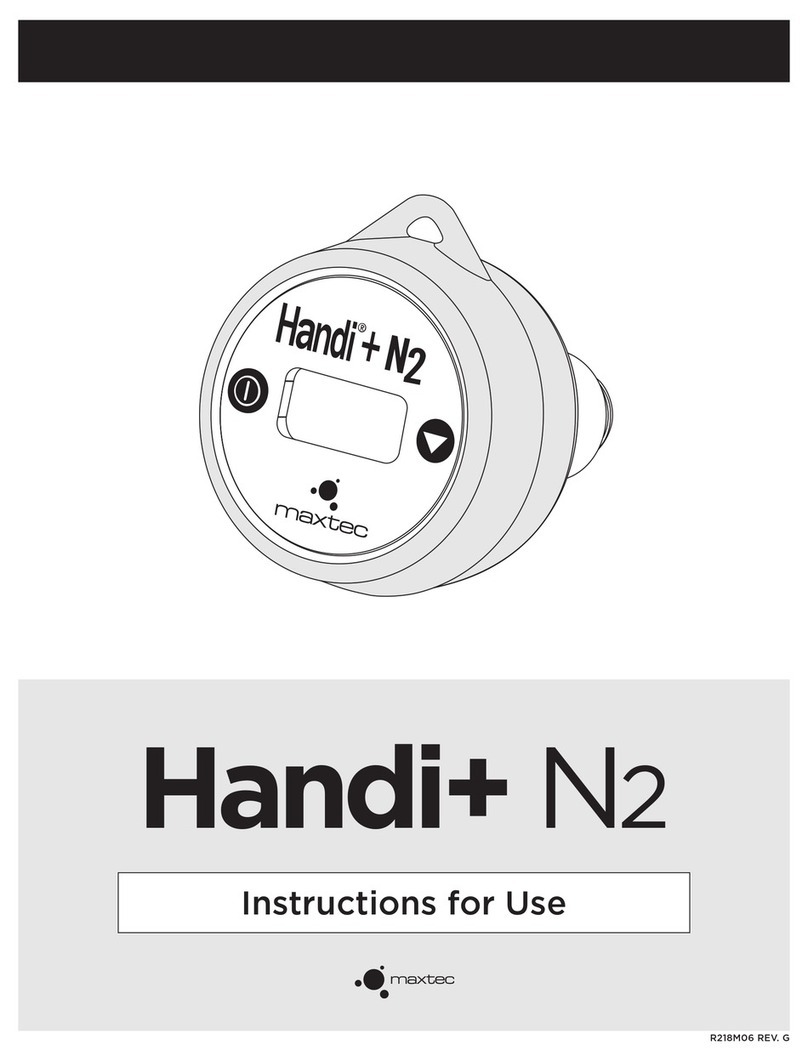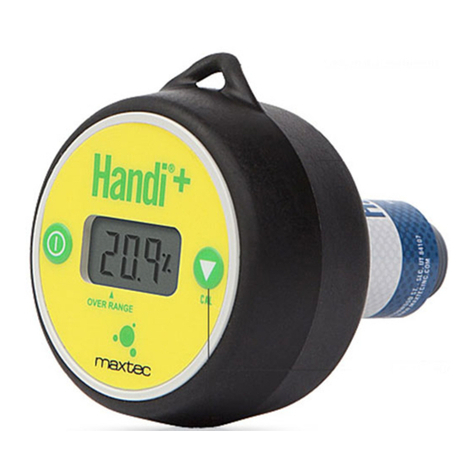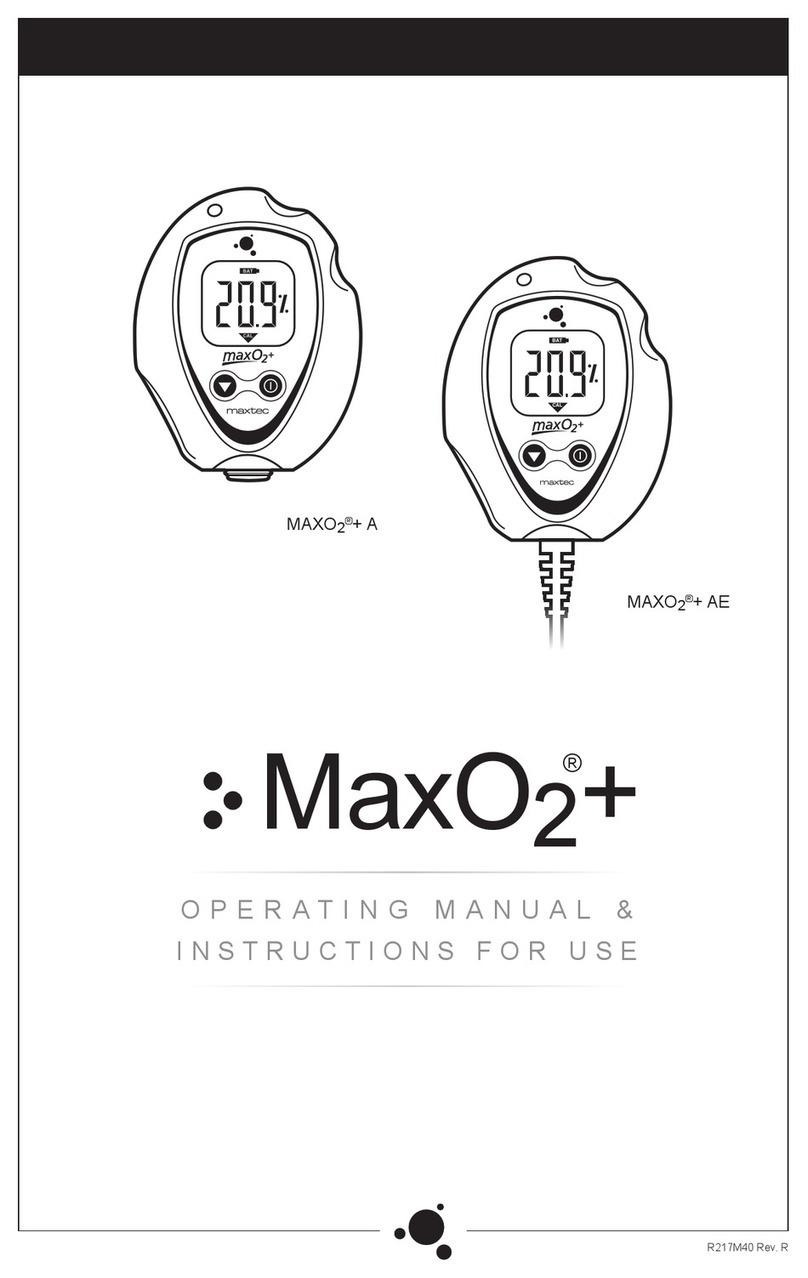
ENGLISH 2WWW.MAXTEC.COM • (800) 748-5355
This manual describes the function, operation and maintenance of the Maxtec Model MaxO2+ A
and AE oxygen analyzer. The MaxO2+ family of Oxygen Analyzers utilizes the Maxtec Max-250
oxygen sensor and is engineered for fast response, maximum reliability and stable perfor-
mance. The MaxO2+ is designed as a tool for use by qualified personnel to spot-check or mea-
sure oxygen concentration of delivered air/oxygen mixtures. The MaxO2+ A and AE Analyzers
are not intended for use in continuous monitoring of oxygen delivery to a patient.
Product Disposal Instructions:
The sensor, batteries, and circuit board are not suitable for regular trash dis-
posal. Return sensor to Maxtec for proper disposal or dispose according to local
guidelines. Follow local guidelines for disposal of other components.
CLASSIFICATION
Protection against electric shock..........................................................................................II, Type B
Protection against water................................................................................................................IPX1
Mode of operation..............................................................................................................Continuous
Sterilization...................................................................................................................See section 7.0
Flammable anesthetic mixture .....................................................Not suitable for use in presence
of a flammable anesthetic mixture
WARRANTY
The MaxO2+ Analyzer is designed for medical oxygen delivery equipment and systems. Under
normal operating conditions, Maxtec warrants the MaxO2+ Analyzer to be free from defects of
workmanship or materials for a period of 2-years from the date of shipment from Maxtec, pro-
vided that the unit is properly operated and maintained in accordance with Maxtec’s operating
instructions. Based on Maxtec product evaluation, Maxtec’s sole obligation under the forego-
ing warranty is limited to making replacements, repairs, or issuing credit for equipment found
to be defective. This warranty extends only to the buyer purchasing the equipment directly
from Maxtec or through Maxtec 's designated distributors and agents as new equipment.
Maxtec warrants Max-250 oxygen sensor in the MaxO2+ Analyzer to be free from defects in
material and workmanship for a period of 2-years from Maxtec’s date of shipment in a MaxO2+
unit. Should a sensor fail prematurely, the replacement sensor is warranted for the remainder
of the original sensor warranty period.
Routine maintenance items, such as batteries, are excluded from warranty. Maxtec and any
other subsidiaries shall not be liable to the purchaser or other persons for incidental or con-
sequential damages or equipment that has been subject to abuse, misuse, mis-application,
alteration, negligence or accident.
These warranties are exclusive and in lieu of all other warranties, expressed or implied, includ-
ing warranty of merchantability and fitness for a particular purpose.
WARNINGS
Indicates a potentially hazardous situation, if not avoided, could result in death or serious
injury.
◆ Never install the sensor in a location that will expose the sensor to patient’s exhaled breath
or secretions, unless you intend to dispose of the sensor, flow diverter and tee adapter.
◆ Improper use of this device can cause inaccurate oxygen readings which can lead to
improper treatment, hypoxia or hyperoxia. Follow the procedures outlined in this user
manual.
◆ Not for use in an MRI environment.
◆ Device specified for dry gas only.
◆ Never allow an excess length of tubing, lanyard or sensor cable near the patient’s head or
neck, which may result in strangulation.
◆ Before use, all individuals who will be using the MaxO2+ must become thoroughly familiar
with the information contained in this Operation Manual. Strict adherence to the operating
instructions is necessary for safe, effective product performance.
◆ This product will perform only as designed if installed and operated in accordance with the
manufacturer’s operating instructions.
◆ Use only genuine Maxtec accessories and replacement parts. Failure to do so may seriously
impair the analyzer’s performance. Repair of this equipment must be performed by a qual-
ified service technician experienced in repair of portable hand held medical equipment.
◆ Calibrate the MaxO2+ weekly when in operation, or if environmental conditions change
significantly. (i.e., Elevation, Temperature, Pressure, Humidity — refer to Section 3.0 of this
manual).
◆ Use of the MaxO2+ near devices that generate electrical fields may cause erratic readings.
◆ If the MaxO2+ is ever exposed to liquids (from spills or immersion) or to any other physical
abuse, turn the instrument OFF and then ON. This will allow the unit to go through its self
test to assure everything is operating correctly.
◆ Never autoclave, immerse or expose the MaxO2+ (including sensor) to high temperatures
(>70°C). Never expose the device to pressure, irradiation vacuum, steam, or chemicals.
◆ This device does not contain automatic barometric pressure compensation.
◆ Although the sensor of this device has been tested with various anesthesia gases including
nitrous oxide, Halothane, Isoflurane, Enflurane, Sevoflurane and Desflurane and found to
have acceptably low interference, the device in entirety (including electronics) is not suit-
able for use in the presence of a flammable anesthetic mixture with air or with oxygen or
nitrous oxide. Only the threaded sensor face, flow diverter, and “T” adapter may be allowed
to contact such a gas mixture.
◆ Not for use with inhalation agents. Operating the device in flammable or explosive atmo-
spheres may result in fire or explosion.
◆ This product is not intended as a life-sustaining or life-supporting device.
◆ Medical oxygen should meet the requirements of USP.
◆ The MaxO2+ and sensor are non-sterile devices.
◆ In the event of exposure to an ELECTROMAGNETIC DISTURBANCE the analyzer may display an
E06 or E02 error message. If this occurs, turn the instrument OFF, remove the batteries and
wait 30 seconds. Then, re-load the batteries and allow the unit to go through its self-test
diagnostics to make sure everything is functioning correctly.
CAUTIONS
Indicates a potentially hazardous situation, if not avoided, could result in minor or moderate
injury and property damage.
◆ Federal Law (USA) restricts this device to sale by or on the order of a physician.
◆ Replace the batteries with recognized high quality AA Alkaline or Lithium batteries.
DO NOT use rechargeable batteries.
◆ If the unit is going to be stored (not in use for 1 month), we recommend that you remove
the batteries to protect the unit from potential battery leakage.
NOTE: The latest edition of this operating manual can be downloaded from our website at www.maxtec.com
Conforms to:
AAMI STD ES60601-1, ISO STD
80601-2-55, IEC STDS 60601-
1-6, 60601-1-8 & 62366
Certified to:
CSA STD C22.2 No. 60601-1
Maxtec
2305 South 1070 West
Salt Lake City, Utah 84119
USA
phone: (800) 748.5355
fax: (801) 973.6090
email: sales@maxtec.com
web: www.maxtec.com
